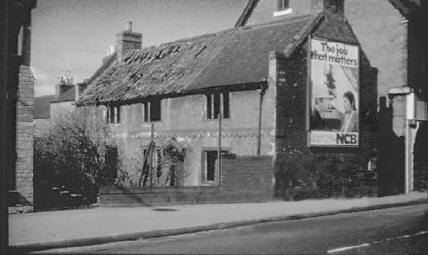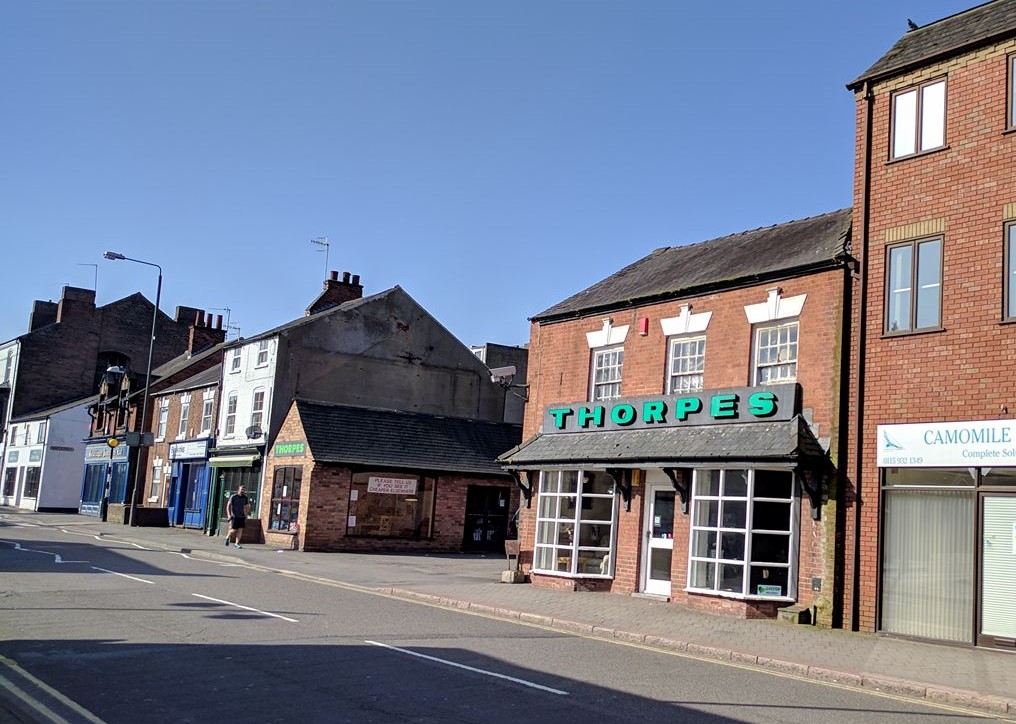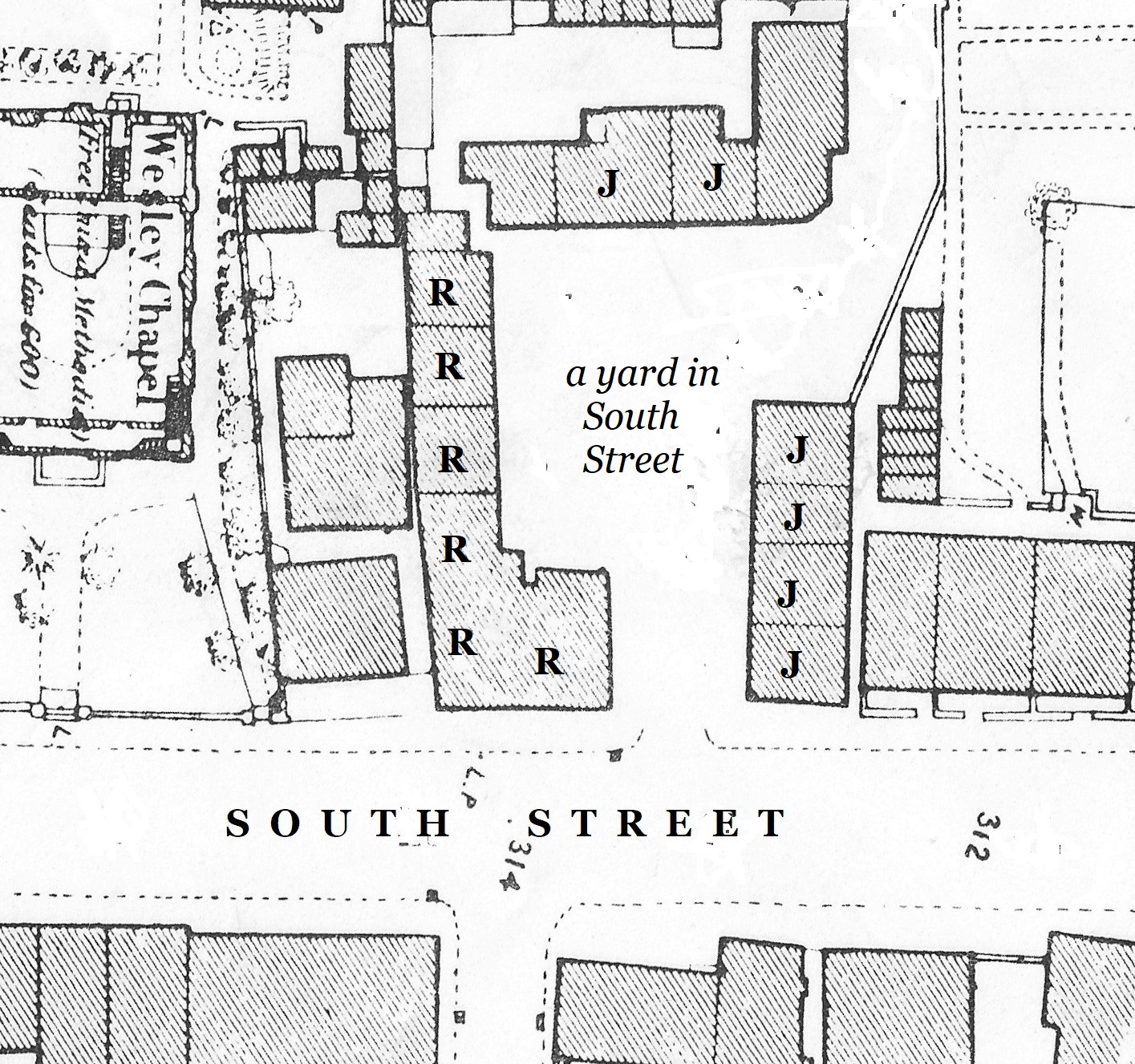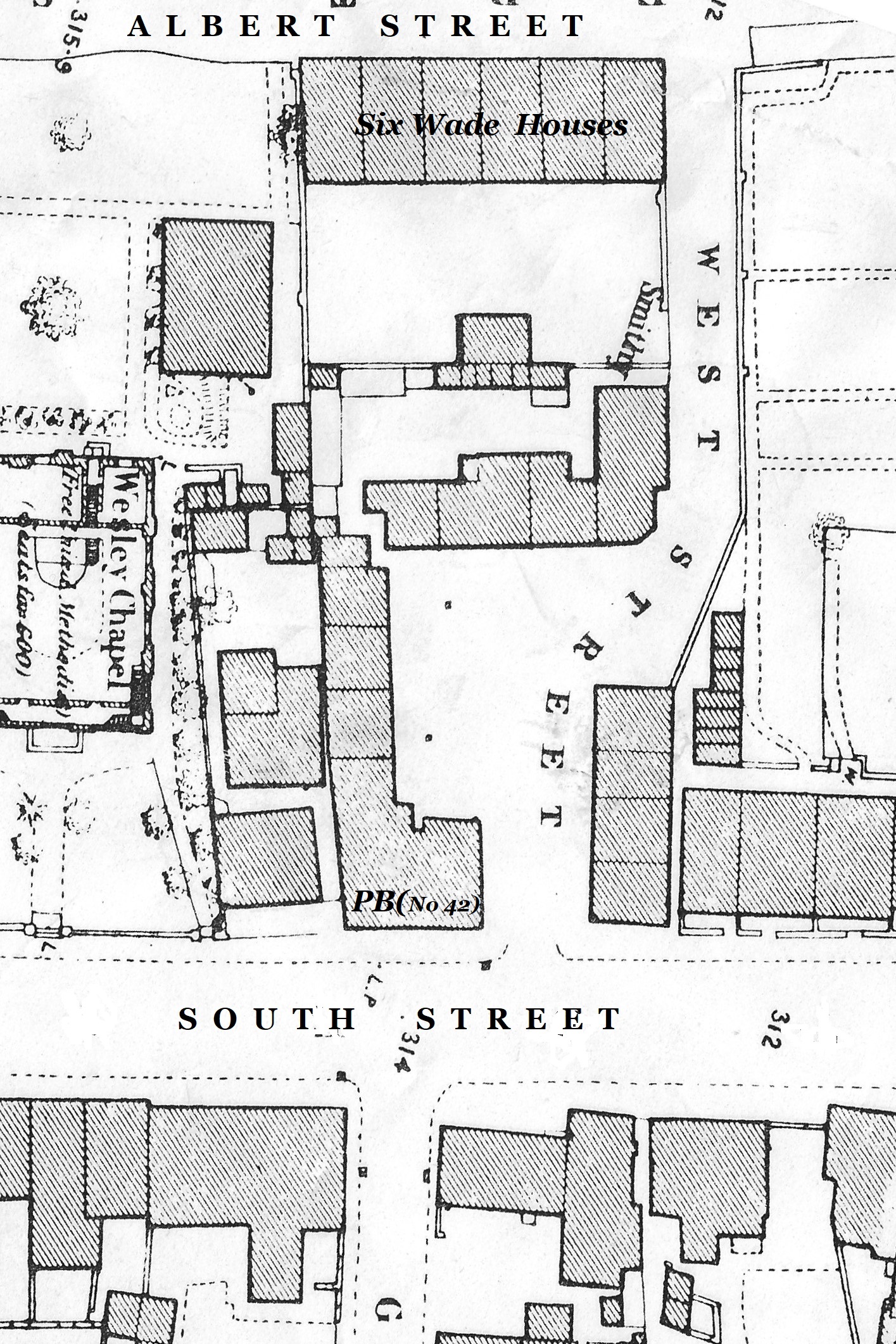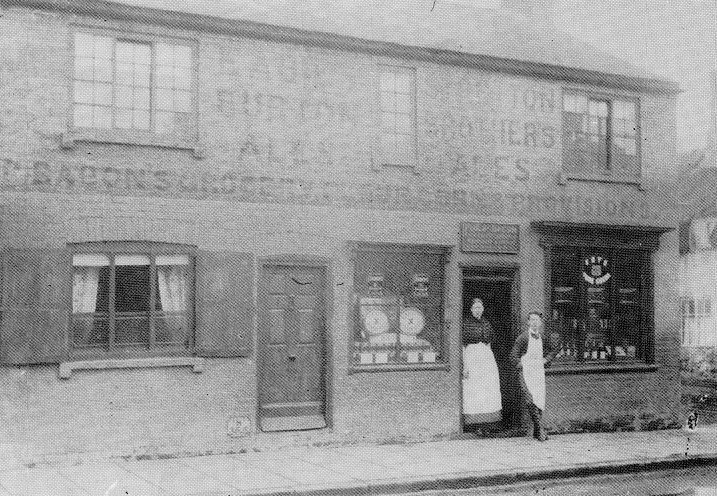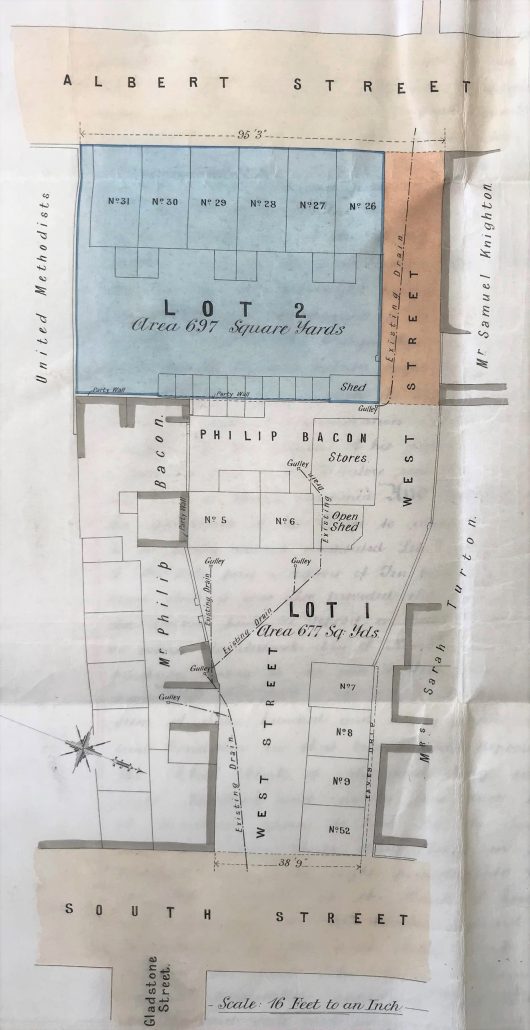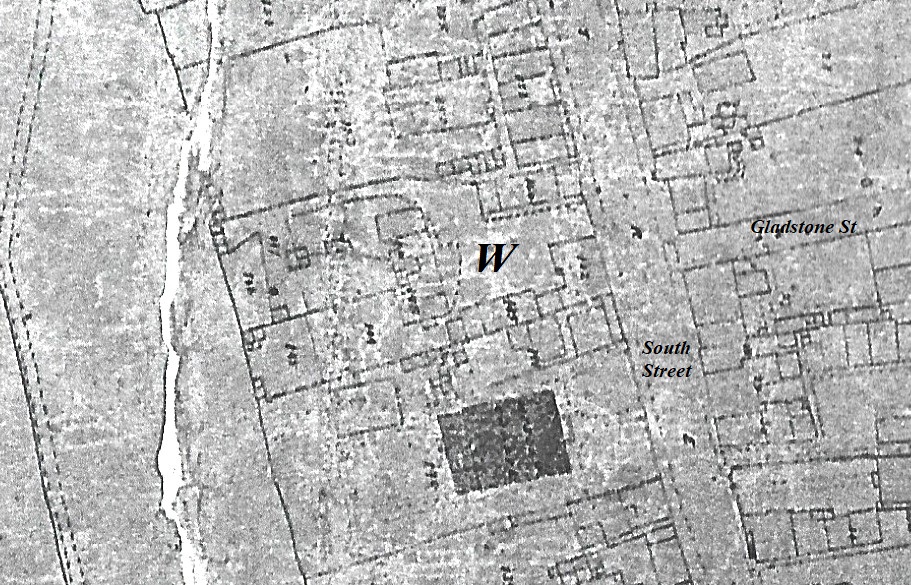Are Wide Yard and West Street different Ilkeston locations, both lying adjacent to South Street ?
If you walk along South Street, from Queen Street towards White Lion Square, on your right-hand (west) side you will pass West Street — it is almost opposite Gladstone Street.
What you will not pass, or find, is Wide Yard.
However, some sources suggest that there was a ‘Wide Yard’ distinct from West Street, somewhere along South Street.
For example, the Ilkeston and District Local History Society website describes Wide Yard as an “extinct area off west side of South Street. Roughly opposite Weaver Row“, thus placing it close to the present-day sites of the Treetops Hospice and Post Office outlets.
And further in the same website is a photo taken from South Street of buildings, labelled “The cottages in the Wide Yard pictured shortly before their demolition circa 1972. The raised brickwork at both gable ends point to the fact that this roof was once thatched“.
The same photo (below) appears in the Society’s publication, ‘Top of Town‘, again seeming to confirm Wide Yard as about 50 yards or so, south, past Queen Street. And certainly apart and separate from present-day West Street.
This is taken from Ilson Bygones Facebook page, posted by Janette Allen (2015)
———————————————————————————————————————————————–
The memories of Adeline Wells
A few of the letters written by Adeline Wells to the Ilkeston Advertiser in the 1930s describe this part of South Street — which we have just explored.
She recalls that, at the southern corner of the junction of Queen Street with South Street, there was for many years a potato patch until George Haslam built a house upon it (this was Euclid House, built around 1884 — which at present houses South Perk Sandwich Bar and an outlet for Keith Hall Beauty Room).
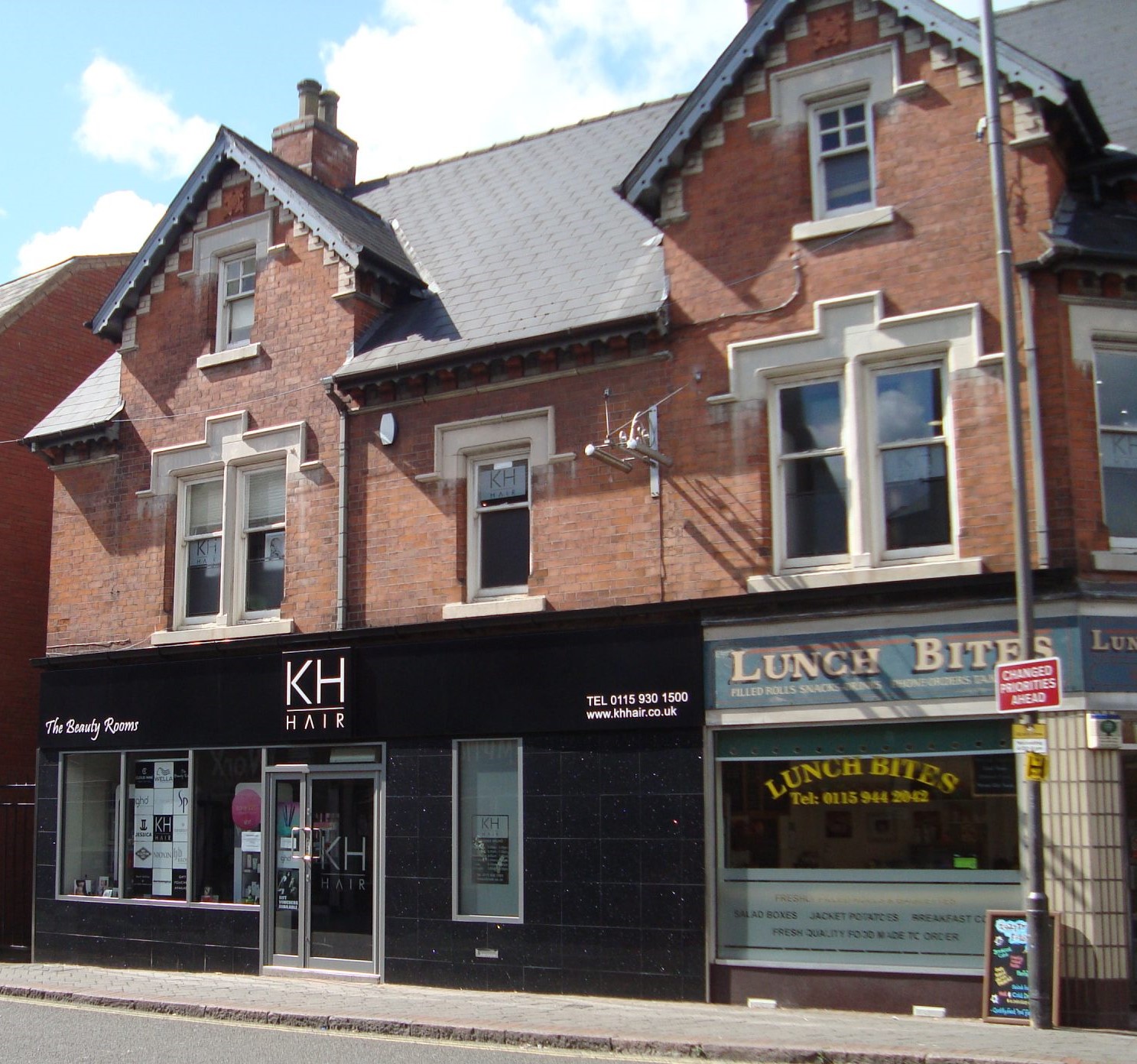
Next door, in South Street but facing southwards, was the Old White House, built by Francis Sudbury senior — here lived the Sudburys until they moved across the street, at which time the eldest Sudbury son, William, remained in the house, trading as a butcher. And when he moved out in the 1860’s, in moved shepherd George Flint and his family.
After this Old White House was the Nag’s Head Inn. (This survived until the early 1980’s at which time it was sold and became part of the Thorpes Furniture Store — some of the old facade can be seen in the upper storey of the northern section of the store.)
The Nag’s Head Inn c 1980 (left) and Thorpes, the new ‘tenant’ c 2018 (Christopher Simpson/Ilson Bygones Facebook page)
After the inn came a row of six cottages — at some time they housed a Clarke family, Harrisons, Smiths, Rowleys, Mrs. Gregory and possibly others. In great part this list matches the families listed in this part of South Street on the 1861 and 1871 censuses.
All of these have just been described, and so …
…. finally, at the northern corner of West Street with South Street was the home of the Platts family. …. that is, just before we reach the white premises, on the extreme left of the last photo above.
———————————————————————————————————————————————-
So where was Wide Yard ?
If we examine the 1841 and 1851 censuses for Ilkeston we can find no listing of Wide Yard or West Street. However within the Rate Book for the town, dated 1849, there is one explicit mention of Wide Yard, next to the residence of Thomas Watthew … this is the first reference to the yard that I have been able to find. There are a further ten premises listed in the Rate Book which may be situated in Wide Yard although the reference is ambiguous.
The baptisms records for St. Mary’s Church also have a couple of mentions for the Yard. The first one is for September 1852, recording the baptism of Mary Burrows, daughter of framework knitter Isaac and Mary (nee Siddons). Now it would appear that this Burrows couple were living in Boot Lane (later known as Stanton Road) at that time, and continued to live there for the rest of their married life. However Mary Burrow’s father, John Siddons, and her brother Joseph, were living in South Street, just a few doors from Thomas Watthew. Was this at Wide Yard and could Mary have returned to the Siddons family home there, for the birth of her daughter ?
The second reference to Wide Yard in the baptism records is from July 5th 1854 and lists the baptisms and births of three children — Jethro, Mary and Hannah — to Thomas Wathey and his wife Eliza (nee Clifford). This reference also records that Thomas is ‘deceased‘ — he had died on June 16th 1854.
The Fritchley Estate in South Street
My thanks go to Jim Beardsley for his collection of documents about this area … they form the basis of the detail below (though any errors will stem from my misinterpretation of his papers)
According to the 1849 Rate Book the property of Thomas Watthew/Wathey and other adjacent buildings were owned by Richard Fritchley, a Cossall farmer who died on April 9th 1859.
But how did Richard Fritchley acquire them ? … Part 1
Richard was born just a few miles from Ilkeston, in Cossall, Nottinghamshire, in 1779, the son of John and Elizabeth (nee Wilson — she was the sister of Joseph Wilson of Wilton Place ‘fame’). Father John died in 1795 while Elizabeth died several years later, in 1826. In her will she appointed, as ‘devisees’, tallow chandler Moses Mason of Bath Street, Ilkeston, and farmer Thomas Sills of Cossall Marsh. And by this time, these buildings in South Street were already owned by the Fritchley family.
On April 17th 1827, Richard Fritchley paid £149 to the two devisees to purchase six houses from his late mother’s Ilkeston estate. These were on the south side of ‘a yard in South Street’ and at that time were occupied by Thomas Henson, John Whitehead, John Leadbetter, Thomas Freeman (then Ann Clarke), Robert Clifford and John Siddons. Included in the price was a piece of land and gardens on the south side of the yard, adjoined and belonging to, these six houses. The total area of the property purchased by Richard was approximately 720 square yards.
Plan 1: This is adapted from the Local Board Map of 1866 and the O.S. Map of c1879/1880. The six houses purchased by Richard in 1827 are marked on the left/south side of the map.
At this same time, i.e 1827, Richard’s younger brother, James Fritchley, paid £250 to the same devisees to acquire four houses on the north side of the same yard — they were then occupied by William Johnson, George Shaw, Timothy Kelly (or Keeley), and William Hardy. There were a further two houses — occupied by Thomas Harrison and John Thompson — behind the first four and further into the yard. All the houses and their gardens had a common parcel of land attached to them. The total area of the land, gardens and houses was 1100 square yards. (They are marked with a J)
And separating Richard’s purchase from that of James was a pathway 11 feet wide, extending from South Street (then referred to as Town Street) westwards to the house of Thomas Harrison.
But how did Richard Fritchley acquire them ? … Part 2
James Fritchley died at Cossall in January 1830, unmarried and intestate — he was aged 34. Richard, as his eldest brother, was therefore James’s ‘customary heir’ and was granted possession of the six copyhold houses and land which his late brother had purchased.
In 1853 Richard took out a loan of £220 using this property as security. At that time his original six houses were tenanted by John Siddons, Richard (? should this be Edward ?) Wardle, Henry Clifford, Joseph Clifford and Henry Thompson.
As to the block of four houses he inherited from brother James, they had been later occupied by William Johnson, George Shaw, Timothy Keely and William Hardy, but then by John Scattergood, Peter Guilford or Gilford, Mr Pearce and Thomas Wathy or Wathew. The two other houses, behind the four, had tenants James Johnson (son of William) and Thomas Brown.
If you search for the names of these occupants on the 1851 census you will find almost all of them together in a block, labelled simply as South Street.
————————————————————————————————————————————————-
Richard Fritchley passes on his estate
Richard Fritchley died at Cossall on April 9th 1859, aged 81. In his will he instructed his executors to sell off his estate, pay off his loan or mortgage debt, which was still outstanding, and then divide any remainder equally between his children — Richard, Mary, Sarah, Martha, Charles, Jane, Eliza, John, James and Joseph. His executors were his son-in-law John Holmes, a cordwainer who had married Mary Fritchley on June 18th 1840 at Cossall Parish Church, and John Cross, innkeeper at Cossall.
At the end of 1859, under Richard’s will, the properties were put up for auction by the will executors. They were listed as …
… a messuage and shop, fronting South Street, occupied by ‘Mrs. Fritchley … this may have been Richard’s widow, Hannah (nee Wheatley) although she was perhaps with the family farm in Cossall. Her daughter (?) Sarah Fritchley, is listed as a milliner in South Street at this time…. she was later to marry her cousin, Thomas Dodson Fritchley.
… eleven cottages contiguous to the shop (above), then occupied by Messrs. Clifford, Wardle, Flinders, Holmes, Hoggett, Wheatley, and others.
… the yard and large gardens belonging to this property.
1859; Enter John Hardy of Kirk Hallam
The ‘Estate’ was bought by farmer John Hardy of Kirk Hallam, and in the sale agreement, dated April 10th 1860, the names of the house tenants were listed ….
…… the tenants of the six houses on the south side of the yard were Sarah Fritchley, Joseph Clifford, Henry Clifford, Edward Wardle, Enoch Flinders and Sarah Holmes.
….. the tenants of the block of four houses on the north side were James Platts, (Thomas ?) Freeman, Widow Siddons, and Joseph Pollard.
…. and finally, the tenants of the two houses behind this block of four were Joseph Hodgett and Levi Clifford.
On the 1861 census most of these tenants (listed in red above) can be found at Wide Yard, South Street. James Platts is living at the entrance to the Yard while Levi Clifford, son of Joseph, had been living there but may have just moved out before the census. Sarah Fritchley and Widow Siddons are both mysteries at the moment. It would seem therefore that these twelve erstwhile Fritchley properties were situated in Wide Yard, previously ‘a yard in South Street’.
1874; Enter William Wade of Bath Street
Having bought the premises in Wide Yard in April 1860, John Hardy promptly enfranchised them, paying a fee of £200.
Then, in September 1874, he sold it all for £1000 — on September 9th — to grocer William Wade (a purchase which was partially financed by a mortgage taken out by William). Once more the tenants were listed, this time within the conveyance document. They were, on the south side, William Wade, Joseph (should be Thomas ?) Clifford, the widow of Henry Clifford, Edward Wardle, the widow of Enoch Flinders, and Sarah Holmes; in the north-side block of four houses lived Widow Swain, Joseph Freeman, Widow Booth, and Joseph Pollard; with Joseph Hodgett and Levi Clifford in the two houses behind the block of four.
So, of the ten families listed on the 1861 census as living in Wide Yard, eight of them are living in West Street on the following census. Does this mean that the families of Wide Yard had emigrated en masse to West Street in those ten years ?? … including blacksmith William Hodgett who would have needed to relocate his smithy ?
** It was at this time that Albert Street (along with Market and Gladstone Streets) was ‘sewered, levelled, paved, flagged and channelled’. The houses were to come later.
1881; West Street
In the same agreement of sale between the seller John Hardy and the purchaser William Wade, the former had included a strip of land, about 80 yards in length, which he had recently acquired as building land. It lay to the west of the houses, in what was once called ‘Long Crofts’ and was previously owned by Ilkeston joiner Richard England. Long Crofts stretched from approximately Queen Street to Derby Road, roughly parallel with South Street — Adeline refers to this as ‘Englands Fields‘ — and this was land in which Albert Street was at that time being laid out. (The position of that street can be seen in Plan 2 (below))
By 1879 William Wade had taken out further loans and had built six new houses on the newly-laid out Albert Street.
Plan 2: The area in 1881
In a Mortgage Agreement of March 17th 1881, the tenants of all the houses — new and old — were listed, They were Phillip Bacon, James (should be Joseph ?) Clifford, Ann Flinders, Benjamin Wardle, Sarah Holmes, Thomas Roans (or Rowen), (listed twice), William Smith, T(homas) Door or Doar, Ann Freeman, W (should be Robert ?) Henshaw, J Barnes, W(illiam) Starbrook, James Baker, W (should be Thomas ?) Frost, W (illiam) Bailey, J (should be Adkin ?) Toplis, and W Rawlinson.
On the 1881 census Phillip Bacon (marked PB on the map above) can be found living in a house at the corner of South Street and West Street. It was then numbered as 42 but in the later 1880s was renumbered as 54. Those names in red appear living in West Street while those in green are living at numbers 20-24 inclusive of Albert Street … in the new houses built by William Wade.
The Bacon property on South Street, at the entrance to West Street which is at the extreme right
———————————————————————————————————————————————–
1890; Exit William Wade
On December 1st 1890 William Wade repaid all his loans and mortgages in full and the premises were thus reconveyed to him. He died on November 5th 1893.
In his will William had appointed, as trustees and executors, Samuel Robinson, his second wife Louisa Ann (nee Chapman) and his brother-in-law and grocer’s assistant John George William Chapman. In addition he made two specific bequests — of £800 to John George William and of £200 to his wife Louisa Ann. William’s personal estate was to be used to settle these bequests as well as his other debts and funeral expenses. Unfortunately this estate was insufficient to cover all these debts and the two bequests, such that, on September 3rd 1895 parts of William’s real estate were auctioned to cover the shortfall.
This auctioned property can be seen as Lots 1 and 2 on Plan 3 on the left.
It included the six houses which William Wade had built in Albert Street.
Lot 2 was bought by George David Knighton for £720 — the purchaser having spent most of his life at the neighbouring Nags Head Inn, where he had been born, the son of Joseph Knighton and Sarah (nee England — the sister of Richard England of ‘England’s Fields, mentioned above).
On the north side of Lot 2 was the property of Samuel Knighton, an older brother of George David; on the south side was land belonging to the United Methodist Free Church (formerly the Wesleyan Methodist Church); on the east it was bordered by premises owned by grocer Phillip Bacon; ; and on the west was Albert Street.
Lot 1 was purchased at the same auction by grocer Phillip Bacon.
Notice that the houses in Albert Street had now been renumbered. The same had happened to the shops and houses in South Street. Phillip Bacon traded at Number 54 (formerly 42), which I believe is still the number of the premises today.
On this plan the property of ‘Mrs Sarah Turton‘ is noted (right). She was Sarah England who married Joseph Knighton, beerhouse keeper of the Nag’s Head, in 1848. He died of cirrhosis of the liver in 1864 and Sarah spent a few months as a widow before she remarried, to Charles Turton.
William Wade had also owned two houses, with saleshops and coachhouses, at the cornerof Bath Street and Station Road. These were bought by Charles Woolliscroft for £1850.
——————————————————————————————————————————–
And below we see the entrance to West Street from South Street as it is today (2021). If we walked through it and continued on, we would walk out into Albert Street.
—————————————————————————————————————————————–
Are Wide Yard and West Street the same place but with different names ?
Certainly Adeline Wells thinks so…. In one of her letters to the Ilkeston Advertiser, she noted “the wide yard, now West Street“, and in another “The Wide Yard! Yes, we called it the Wide Yard in those days, for it was a yard pure and simple. …. There were gardens at the back, separated from England’s field – now Albert Street – by a thick hedge. It was a cul-de-sac. ….. The Wide Yard later became West Street“.
Adeline and her family were members of the South Street Wesleyan Reformers Methodist Chapel, lived in Queen Street Terrace and later Queen Street and would know this area well.
————————————————————————————————————————————————–
But why would Wide Yard want to become West Street ?? Maybe, to complete the ‘set’ ? — Ilkeston already had a North Street, South Street and East Street. (just joking !!)
Maybe the Yard was no longer a yard but more of a street ?
The map drawn up for the Local Board in 1866 by Charles Sherwood Newman does not name either Wide Yard or West Street but does show a large yard where West Street would be…. it is certainly a yard, with no rear outlet onto Albert Street. This is not surprising as, at that time, Albert Street only extended southwards just past Queen Street !!
Here is the area on the Local Board Map with W showing Wide Yard/West Street. However by 1871 it had been extended, past the rear of what was then named as West Street, to Derby Road. And the yard was opened up so that there was now a way through it, from South Street to the newly formed Albert Street. Thus it could be called a street ?
——————————————————————————————————————————————————
And just like Clark Kent and Superman … you never see Wide Yard and West Street together.

